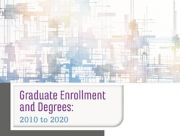You are on CGS' Legacy Site.
Thank you for visiting CGS! You are currently using CGS' legacy site, which is no longer supported. For up-to-date information, including publications purchasing and meeting information, please visit cgsnet.org.

Washington, DC — New data from the Council of Graduate Schools (CGS) on graduate enrollments and degrees demonstrate the continued demand for graduate education in the U.S. According to a CGS report released today, both graduate applications (7.3%) and first-time graduate enrollment (1.8%) increased overall for the Fall 2020 semester, welcome news during the disruptive COVID-19 pandemic. While international graduate first-time enrollment declined 37.4%, domestic enrollment grew 12.9% — growth driven, in part, by increases in traditionally underrepresented students. First-time, part-time graduate enrollment increased by 13.5%. These data are part of the latest CGS/GRE Graduate Enrollment & Degrees: 2010-2020 report.
“Graduate schools had to pivot quickly as the pandemic disrupted traditional modes of instruction, increasing part-time, virtual, and hybrid learning options,” said CGS President Suzanne Ortega. “To see continued growth in first-time enrollment rates during a global pandemic shows confidence in the value of graduate education and the importance of increased flexibility in delivery methods.”
Ortega added that an increase in flexible learning options has supported diversity. “It’s striking that 43.4% of graduate students are enrolled part-time and these students are more likely to be women and students from traditionally underrepresented groups. We’ve long believed that improved access would further diversify the graduate student body, and these data provide supporting evidence.”
Between Fall 2019 and Fall 2020, first-time enrollment among underrepresented minorities grew at a healthy pace. First-time graduate enrollment of American Indian/Alaska Native students increased 8.8%, with corresponding increases of 16.0% for Black/African American students and 20.4% for Latinx students. While this growth is encouraging, Black/African American students constitute 12.8% of U.S. citizens and permanent resident graduate students overall, and remain considerably underrepresented in physical and earth sciences (3.8%), engineering (6.2%), and biological and agricultural sciences (6.6%). Similarly, Latinx students constitute 12.0% of U.S. citizens and permanent resident graduate students, and remain considerably underrepresented in mathematics and computer sciences (9.9%) and physical and earth sciences (10.4%).
Institutions responding to the CGS/GRE Survey of Graduate Enrollment & Degrees for Fall 2020 enrolled more than 1.7 million graduate students. Nearly three quarters (72.9%) of total graduate enrollment was in master’s programs. Over one million of those graduate students, or 59.7%, were women. Education (63.8%), business (53.0%), and health sciences (43.0%) continue to be the three largest broad fields of study and the fields with the largest proportions of part-time graduate students.
About the report
Graduate Enrollment and Degrees: 2010 to 2020 presents the findings of an annual survey of U.S. graduate schools, co-sponsored by CGS and the Graduate Record Examinations (GRE) Board. It is the only annual national survey that collects data on graduate enrollment by all fields of study and is the only source of national data on graduate applications by broad field of study. The report includes responses from 558 institutions and presents statistics on graduate applications and enrollment for Fall 2020, degrees conferred in 2019-20, and trend data for one-, five- and ten-year periods.
###
The Council of Graduate Schools (CGS) is an organization of approximately 500 institutions of higher education in the United States and Canada engaged in graduate education, research, and the preparation of candidates for advanced degrees. The organization’s mission is to improve and advance graduate education, which it accomplishes through advocacy in the federal policy arena, research, and the development and dissemination of best practices.




